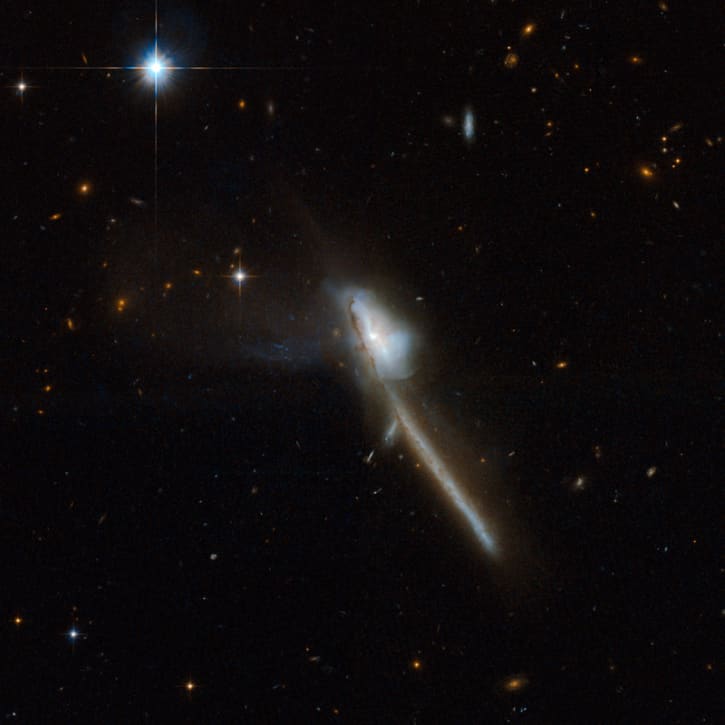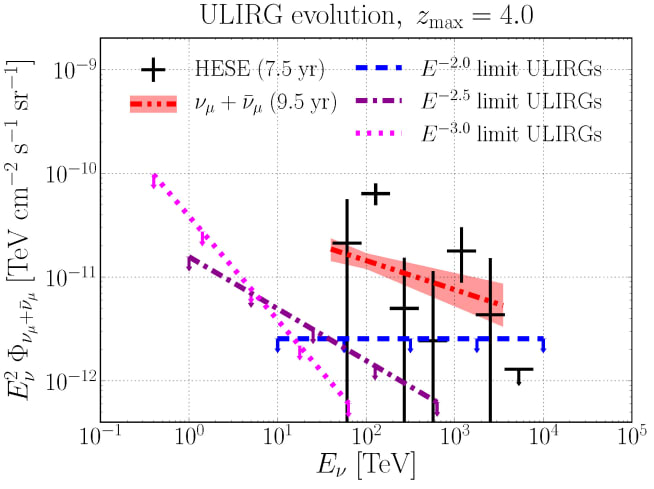By Madeleine O’Keefe and Pablo Correa
In the constellation Ursa Major, there is a galaxy with the uncanny appearance of a particular dental hygiene tool. Aptly nicknamed the “Toothbrush” galaxy, Mrk 273 is actually a merger of two galaxies and an example of an ultraluminous infrared galaxy (ULIRG). It might be a source of astrophysical neutrinos: lightweight, elusive particles created in outer space that the IceCube Neutrino Observatory is trying to detect with its array of over 5,000 sensors buried in a cubic kilometer of ice at the South Pole.
The Toothbrush galaxy was one of 75 ULIRGs examined by the IceCube Collaboration in a recent analysis, which has been accepted for publication by The Astrophysical Journal. Using 7.5 years of data taken by the IceCube Neutrino Observatory, researchers looked to see whether they saw more neutrinos than expected coming from the directions of the 75 ULIRGs, but no excesses were found. This means it is likely that ULIRGs are not solely responsible for the astrophysical neutrino flux, leaving one of the field’s biggest mysteries still unsolved.

Earth is constantly being bombarded with neutrinos. These harmless particles stream through your body at a rate of trillions per second. Some of these particles are part of the mysterious astrophysical neutrino flux, which is the name given to the constant stream of neutrinos coming from the cosmos. In 2013, the IceCube Neutrino Observatory discovered the existence of this flux, and ever since, the IceCube Collaboration has been trying to observe and characterize it. However, we still don’t know where most of these astrophysical neutrinos are coming from, making it one of the main mysteries in the field of neutrino astronomy.
ULIRGs could be contributors to this mysterious neutrino flux. The most luminous objects in the infrared sky, ULIRGs outshine our own galaxy by about a factor of 100. They are mostly powered by regions of intense star formation, called starbursts, where the equivalent of over 100 suns is produced each year. The optical and UV radiation by these young stars is absorbed by the dense clouds of dust and gas in the starburst region, which then re-emit the absorbed radiation at infrared frequencies, resulting in the huge infrared luminosities that characterize ULIRGs. In addition, ULIRGs may host an active galactic nucleus (AGN)—a supermassive black hole that is actively accreting matter—which can also contribute significantly to the infrared luminosity.
Both starbursts and AGN are environments where neutrino production can take place, making ULIRGs excellent candidate sources of astrophysical neutrinos. Moreover, studies have found that ULIRGs could be responsible for a significant fraction of the diffuse neutrino flux seen by IceCube because there are more ULIRGs farther away from Earth. These studies also argue that such neutrino emission from the ULIRG source population could be consistent with the current observational constraints from neutrinos and gamma rays.
To search for neutrinos from ULIRGs, IceCube researchers first selected 75 ULIRGs that were within two billion light-years from Earth. The next step was to examine existing IceCube data and look for excesses of neutrinos from the ULIRGs’ directions. But the IceCube data were full of distracting signals from atmospheric muons and atmospheric neutrinos, making it challenging to identify a possible astrophysical component originating from ULIRGs.
“One of the methods we apply to cope with this problem is to perform a so-called stacking analysis,” says Pablo Correa, a PhD student at IIHE-VUB and a lead on this analysis. “Instead of searching for neutrinos from each ULIRG individually, we search for the combined (or stacked) contribution of all the ULIRGs in our selection. This makes our analysis more sensitive for a weaker astrophysical component that might otherwise remain hidden in the overwhelming atmospheric background.”
Unfortunately, Correa and his collaborators found no excess of astrophysical neutrinos from their 75 ULIRGs in 7.5 years of IceCube data. Nevertheless, they were still able to draw impactful conclusions as the result: They set upper limits on the stacked neutrino flux originating from the selection and extrapolated this to an upper limit on the contribution of the full population of ULIRGs to the diffuse neutrino flux observed by IceCube. They found that ULIRGs cannot be the sole sources that are responsible for the diffuse neutrino observations.

However, the results do not constrain a possible contribution from the less luminous but much more numerous luminous infrared galaxies (LIRGs). A dedicated search from neutrinos from LIRGs, which have properties similar to ULIRGs, would provide insights as to whether these objects contribute to the diffuse neutrino observations. Furthermore, Correa says, other studies could look more closely at the type of AGN found in ULIRGs, which are “prime neutrino source candidates” on their own.
“With more data, and with the prospect of IceCube-Gen2 in the future, we will be able to perform more precise studies searching for the origin of astrophysical neutrinos,” says Correa.
+ info “Search for High-Energy Neutrinos from Ultra-Luminous Infrared Galaxies with IceCube,” IceCube Collaboration: R. Abbasi et al., The Astrophysical Journal 926 (2022) 1, 59, iopscience.iop.org, arxiv.org/abs/2107.03149